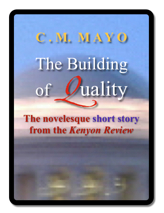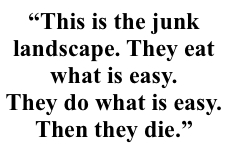|
Author of The Last Prince of the Mexican Empire, etc. |
|
|
|
CM: ¿Quién sabe?
But I can tell you that I have always been fascinated by the
occult, synchronicity, and the spoon-bending weird. KR: I found the names you chose for the main characters in this story interesting — John and Jane Smith, purposefully indistinct names. What's the significance of that choice? CM: John and Jane Smith are unique individuals with talents and tender dreams, but they hold themselves back, without questioning the order of their world. I wanted their names to reflect that aspect of their personalities. KR: This story, like some of your other writings (I'm thinking particularly of Miraculous Air), seems to be a palimpsest of sorts, upon which several layers of a particular history are written. What is it about this form that appeals to you as a writer? CM:
I think of
my stories as nets of images. From the moment Douglas
Glover explained it to me, I was hooked on the concept. In
his essay, "The Net and the Quest for Christa T." in
Notes
Home From a Prodigal Son, Glover writes, "the book
as net will have the appearance of being woven together, that
is, it will have a feeling of going back and forth within itself,
a feeling of simultaneity... achieved primarily through repetition,
repetition of... words, images, and situations." KR: The notion of storytelling is clearly important to you, and you manage to come up with a variety of devices to allude to it or exert some sort of internal storytelling methods in your work (in the case of "A Building of Quality," the stories told by John and Jane's descendants). Can you tell me a bit about how storytelling came to have such significance for you? CM: But isn't it for every one? It's how we make sense of ourselves, our relationships, our whole world. We tell ourselves who we are. What does it mean to be an American? That's a story. We are the stories, which are in our heads. Nothing exists, for sure, outside of our own minds. KR: What cultural differences do you see between the way stories are told and the way storytelling is valued in the U.S. and Mexico? CM: Never mind Mexico, what is the "U.S."? Maine, Florida, or how about Grand Forks, North Dakota? We've got Alaskan pipe line repairmen, we've got Cincinnati Lebanese-America country club-goers, the owner of a BBQ shack in Tupelo, Mississippi, Arnold Schwarzenegger, Miss Manners, surfer dudes, and I am sure, an eightyseven year-old yoga instructor living in a commune outside of Eugene, Oregon. Toddlers like stories, too! We have literary short stories, but also TV shows, movies, People magazine, gossip— stories swirl around in a multitude of forms by and for a multitude of sensibilities. So yikes! I do not see two forests, the U.S. and Mexico, I just see gazillions of trees. KR: The names of certain cultural landmarks, particularly chain restaurants like KFC and Pizza Hut, pop up in this story and others to represent a distinct environment. What are you trying to say about a setting by using these elements? CM: That this is the junk landscape. They eat what is easy. They do what is easy. Then they die. KR: One of the things I really enjoy about your work is your ability to establish a well-drawn sense of place. Do you think living in a country other than the one in which you grew up has made you more sensitive to the details that help establish a strong setting? CM: Yes, and I think that traveling or living anywhere yonder from one's home turf tends to open up one's eyes, ears— all the senses. KR: Are you still splitting your time between Washington, D.C., and Mexico City? Are there any particular challenges to transitioning back and forth between the cultures, languages, climates, etc.? CM: I just wish I had a lighter weight laptop computer. I see a lot of Mexicans in Washington, and a lot of Americans in Mexico City. The traffic's better in Washington, however, and in Mexico City, the tacos are much better. KR: In Miraculous Air, you write, "Many of my favorite writers were expatriates." Was this true before your move to Mexico or has it been something of an empathetic response since you've lived there? CM: Yes, this was true before my move to Mexico— though I'd never thought about it much until I came to writing that line. I've been a huge fan of V.S. Naipaul every since my freshman year in college. After I graduated, I went through a Paul Bowles phase, devoured all his stories and novels, and I even went to a writing workshop with him in Tangier. In Mexico, I discovered Fanny Calderón de la Barca, the Scottish-born wife of Spain's first ambassador to Mexico. Her Life in Mexico, which was published in 1843 and is still in print, is one of the most deliciously splendid books I know. KR: Knowing your background, I couldn't help but notice the figures and tabulations in this story regarding the damage caused by the storm. In what ways does your history in finance and economics factor into your writing? CM: First, when I wrote this story, I'd just moved a van-load of furniture and art over the border, so I was intimately familiar with all the terms of insurance contracts. Second, I earned two degrees in economics and later taught international finance at the ITAM, a university in Mexico City, so financial terms are relatively easy for me to throw around. I find that financial mumbo-jumbo oftentimes has a funny and scary kind of energy. KR: How does one make such a dramatic career change? What first led you to consider writing as a livelihood? CM: For me, a "career change" is nothing more than following my heart. My heart said, yecch, I'm sick of economics, this is what you need to do now. So, OK. But I don't know that I would call the kind of literary writing I do a "livelihood"! But when I'm old, I'm not going to care two fleas whether some story or poem or essay I wrote made say, $10 or $1,000 back in 2003. But I will care whether the story is good, at least in my own mind. What I'm saying is, if there's money in a literary short story, I'm happy to have it, but that is not my motivation for writing it. (After all, many literary magazines pay only in contributors copies.) That said, I have done freelance work for newspapers and magazines, and also some translating and editing. But generally, I write what I write because my heart tells me: Do this now. Which isn't to say money doesn't matter. It's like hay for the horse. Gotta have it or the horse isn't going anywhere, but the horse, not the hay, is the point. And there are many, many ways to get hay. For instance, real estate investments. KR: Tell me a bit about how Tameme came into being. Did you found it on your own or did you work with collaborators? CM: Tameme (pronouned "ta-meh-meh")
is an annual(ish) English/Spanish bilingual journal of new writing
from North America—Canada, the U.S., and Mexico. Tameme,
by the way, is a nahuatl word for porter or messenger. I got
the notion to found it when I was living full-time in Mexico
City and just beginning to publish my short stories in U.S. literary
journals, and translating Mexican poetry. NAFTA was the big thing
then, and it seemed to me that very little of the enormous body
of contemporary writing from Canada, the US and Mexico was being
translated. I was seeing translations of Eudora Welty, Walt Whitman,
Ernest Hemingway— but what about Edwidge Danticat? A. Manette
Ansay? Margaret Atwood? Almost no one in Mexico had heard of
them. And it was the same situation with Mexican work being translated
into English. KR: What are the challenges involved in producing a literary journal, particularly one devoted to translation? Have you found a U.S. distributor yet? CM:
The challenges
are a many-headed dragon! As I am sure you must know at the Kenyon
Review. It has been an enormous education for me, as a writer,
to be sitting in the editor's chair— and the marketing director's,
and the public relations person's and heck, the general dogsbody's.
Now, when I have anything of mine published, I am so much more
appreciative knowing as I do all the unseen work that goes into
it. And when I find the journal in a bookstore, I sometimes even
e-mail the editor to say, "Bravo! I saw it at the Georgetown
Barnes & Noble!" Because I know now that just getting
it onto the newsstand is an achievement. KR: I read that even before you learned Spanish, you had studied French and German. When did your interest in language begin and where do you think it came from? CM: In highschool I had a splendid teacher, Madame Jarman, who, by the way, was the translator for Göring in the Nüremburg Trials. And I never asked her about that! I was so young; I just didn't think. Madame, as we called her, was from Alsace-Lorraine, so she spoke both French and German. She sang Edith Piaf songs on her guitar, she was crazy about the TV actor Telly Savalas, and she had about a hundred itty bitty dogs that tried to nip anyone who tried to get near them. She also wore these heavy hand-knit knee socks, and when she had a cold she would press a eucalyptus-soaked handkerchief to her mouth— you could smell it down the stairs. She made us stand and recite poems, and if we stumbled, we were "Dizzy Lizzies" and I think she must have made every girl in the class cry at least twice. Her sister had been married to a famous painter in Paris and Madame herself, in her eighties, married a four star general! Ralph Smith. He lived to a 104. So Madame, if she was tiny, was a big personality. I was terribly fond of her, and later, when I went to Mexico, learned Spanish, and published Tameme, I think she was proud of me. Little had I known: she had lived in Guatemala and she spoke Spanish! KR: In poetry, particularly, the rhythm and sound of the language can be as significant as the literal meaning of the words. In translation, how do you bring those qualities from a romance language like Spanish to a more Germanic language like English? CM: English may be Germanic but it also has a vast number of Latinate words, as it is a blending of Anglo-Saxon and Norman French— not to mention a motley bunch of other stuff. In fact, I read somewhere that English has twice the number of words as Spanish. So, translating into English gives one an enormous range of choices for achieving effects of rhythm and sound. In practice, I just try to feel the music of a line and choose words intuitively. KR: I understand you're working on a novel now. Having tackled short fiction, nonfiction and translations, not to mention economics texts, what keeps you moving from one format to another? CM: Again, I write what my heart tells me to write. And I expect I'll continue doing that— whether it will be stories or a novel, something else, I have no idea. KR: Can you tell me anything about
the novel and where you are in terms of its progress? |



 countryside"
that so much of America has become. Kunstler writes, "The
average citizen— who went to school in a building modeled
on a shoe factory, who works in a suburban office park, who lives
in a raised ranch house, who vacations in Las Vegas— would
not recognize a building of quality if a tornado dropped it in
his yard." I read that and I thought, whew, nasty. But hey,
what if?
countryside"
that so much of America has become. Kunstler writes, "The
average citizen— who went to school in a building modeled
on a shoe factory, who works in a suburban office park, who lives
in a raised ranch house, who vacations in Las Vegas— would
not recognize a building of quality if a tornado dropped it in
his yard." I read that and I thought, whew, nasty. But hey,
what if?

